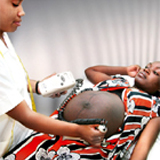
The extensive research and analysis presented in The Lancet’s Stillbirths Series provides the most comprehensive assessment to date of global numbers and causes of stillbirths, perceptions and beliefs around the world, and the solutions to prevent stillbirths—well-known interventions as well as innovations.
The Series presents the very latest data showing that more than 2.6 million stillbirths occur each year—at least 7,000 each day. While 98% of these occur in low-income and middle-income countries, stillbirths also continue to blight wealthy nations, with around 1 in every 320 babies stillborn in high-income countries. The Series addresses stillbirth rates and causes in all countries, and sets key actions by 2020 to halve this event that devastates parents and families.
Written by a group of 69 authors, from more than 50 organisations and 18 countries, the six Series papers, two research Articles, and eight linked Comments show how stillbirths have been neglected by the global public health community. They provide new analysis of the problem and the results of incorporating stillbirths into existing health-system packages for women and babies, with examples of success and missed opportunities especially for the poorest families.
The Series culminates in a call for action to the international community, individual countries, professional organisations, and families to take a stand for stillbirths. Everyone has a role to play and together stillbirths can and must be counted and reduced.
The international team of authors is led by Dr Joy Lawn (Saving Newborn Lives/Save the Children, Cape Town, South Africa) and Vicki Flenady, Mater Medical Research Institute and University of Queensland, Australia and Chair of the International Stillbirth Alliance (ISA). The work was primarily funded by the Bill and Melinda Gates Foundation.
> Download the executive summary
Access the Series (Lancet registration required for full access)
Stillbirths: why they matter. Frøen JF, Cacciatore J, McClure EM, et al, for The Lancet’s Stillbirths Series steering committee.
Stillbirths: Where? When? Why? How to make the data count? Lawn JE, Blencowe H, Pattinson R, et al, for The Lancet’s Stillbirths Series steering committee.
Stillbirths: what difference can we make and at what cost? Bhutta ZA, Yakoob MY, Lawn JE, et al, for The Lancet’s Stillbirths Series steering committee.
Stillbirths: how can health systems deliver for mothers and babies? Pattinson R, Kerber K, Buchmann E, et al, for The Lancet’s Stillbirths Series steering committee.
Stillbirths: the way forward in high-income countries. Flenady V, Middleton P, Smith GC, et al, for The Lancet’s Stillbirths Series steering committee.
Stillbirths: the vision for 2020. Goldenberg RL, McClure EM, Bhutta ZA, et al, for The Lancet’s Stillbirths Series steering committee.
Articles
National, regional, and worldwide estimates of stillbirth rates in 2009 with trends since 1995: a systematic analysis. Cousens S, Stanton C, Blencowe H, et al.
Major risk factors for stillbirth in high-income countries: a systematic review and meta-analysis. Flenady V, Koopmans L, Middleton P, et al.
Commentaries
Bringing stillbirths out of the shadows. Mullan Z, Horton R.
Plausible estimates of stillbirth rates. Walker N.
The challenges of reducing risk factors for stillbirths. Cnattingius S, Stephansson O.
Stillbirths: breaking the silence of a hidden grief. Scott J.
Stillbirths: the professional organisations’ perspective. Serour GI, Cabral SA, Lynch B.
Stillbirths: missing from the family and from family health. Darmstadt GL.
Addressing the complexity of disparities in stillbirths. Spong CY, Reddy U, Willinger M.
Counting stillbirths: women’s health and reproductive rights. Kelley M.